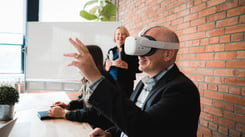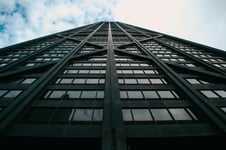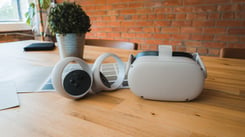While the debate will carry on around the market’s expectation of VR’s potential versus the realities of consumer adoption, VR has gone ahead and found a growing number of ways to make business, and industry, more efficient, more effective and better connected to its customers. And not always in the most obvious ways. Take VR for retail as an example. With the holiday season upon us, retailers are looking for exciting experiences to lure shoppers in-store, and away from clicking the shopping cart button on online behemoths. VR for retail has a place to play in deepening shopping engagement - regardless of whether or not you own a headset, or ever plan to shop inside one. The reality is that most of us probably won’t use VR to buy shoes or clothing - there wouldn’t be much point. VR wouldn’t solve a problem that still images and videos can’t resolve in terms of showing off the product, and it doesn't get you any closer to the real world fit and appearance of the product. Indeed, some manufacturers will probably avoid using VR, given that it’s all too real - a VR representation of the hottest smartphone on the market looks a lot like a black brick - it lacks the stylized gleaming corners and screen angle of a stylized still photo generated by a marketing department. It's controlled by the user, not the designer, and that's a pretty big shift. But even if you didn’t wear a headset to purchase your fall wardrobe with VR retail shopping tools, that doesn't mean VR isn’t transforming the retail industry.
Although Chinese e-commerce behemoth Alibaba has led the way in creating the first virtual mall, VR shopping remains a channel that’s yet to mature. But the technology is starting to have a big impact for retailers, both behind the scenes and through influencing shoppers with savvy brand storytelling.
Sharing Experiences
UK retailer TopShop has been leading the way with brand engagement through VR, which makes sense given their tech-savvy demographic. Research from Sonar (J. Walter Thompson’s proprietary research unit) showed that Generation Z is very interested in the experiential nature of stores and subsequently, 80% of them are more likely to visit a store offering VR and AR technology. There has also been plenty written on how millennials prefer authentic experiences to material items, and TopShop’s use of VR is combining in-store and virtual retail experiences.
VR drew so much attention that TopShop created a new experience in the Spring of 2017 to transform its flagship Oxford Street (London) store into a VR waterslide through the city. Participants used a real slide in store, combined with VR gear to expand the experience. While the ties between the content and brand aren’t as on the nose in this second execution as it was in transporting viewers to fashion week as above, what is clear is that TopShop is finding ways VR can engage shoppers through in-store experiences.
Try Before You Buy
Beyond helping retailers perfect their in-store experiences, VR is also helping brands tell their story to customers in a very different way and align their products very specifically with the environments they’re built for. As an example, North Face cleverly employed VR to position itself clearly as a progressive company which understood, and was fully at home in epic environments. Visitors to North Face stores were invited to don VR headsets and tour California’s Yosemite National Park and the Moab desert alongside climbing celebrities or try winter gear in a harsh arctic environment.
Merrell hiking boots also created an experience with VR for retail, where shoppers could virtually hike along a crumbling rocky edge. Even those who have never gone hiking will tell friends about the experience - as about 81% of those who try VR are likely to do. The interactive nature of immersive VR makes campaigns such as these far more impactful to consumers, engaging them on an emotional level and, at the same time, closely aligning purchasable products to exciting and visceral experiences which they want to share.
Build It (virtually) and They Will Come (or not, but you’ll know before you’ve built it)
Retailing is considered part art, part science and, for the science part, everything is considered. From analyzing the finest details of store layouts to perfecting lighting plans, display heights, and ambient sound, each element of retail space is thought through and tested. VR for retail technologies are being used to create virtual stores for just this purpose. These virtual replications of in-store environments are used to track user movement through stores to flag potential traffic flow issues, conduct A/B testing the effectiveness of display layouts, etc - all before anything is constructed and any heavy costs have been incurred.
Feeling the heat
Another VR tool in retailer’s belts is heat mapping analytics. Yulio recently launched VR heat mapping technology able to track a viewer's gaze within 360 degree virtual environments and provide detailed analytics on what is their drawing attention. Using the technology, retailers are able to test and refine store display and signage configurations based on concise data collected from test subjects. Heat mapping technology can also be used in a similar way by brands looking to understand the level of attention their products are drawing within displays densely filled with competitors. If products are being bypassed and/or specific competitive brands are getting high levels of engagement, brands are able to evaluate factors such as product packaging, location on displays, etc.
As more brand marketers discover the power of VR, watch for virtual experiences at retailers this holiday season - it may have been used to build the store you’re visiting, or create an experience that makes consumers want to actually visit stores, a strong driver for retailers slugging it out with online powerhouses like Amazon.
So while the store of the future may or may not be one that we visit virtually, the fact that today people aren’t slipping on a headset each time they want to buy a new pair of shoes, doesn’t mean VR isn’t being used - right now - by a retailer near you. If you’re wondering how you can create a VR experience for your brand, check out our free accounts at Yulio, or do some more research with our state of VR presentation.



.jpg?width=245&height=150&name=active-adult-beautiful-1799244%20(1).jpg)


